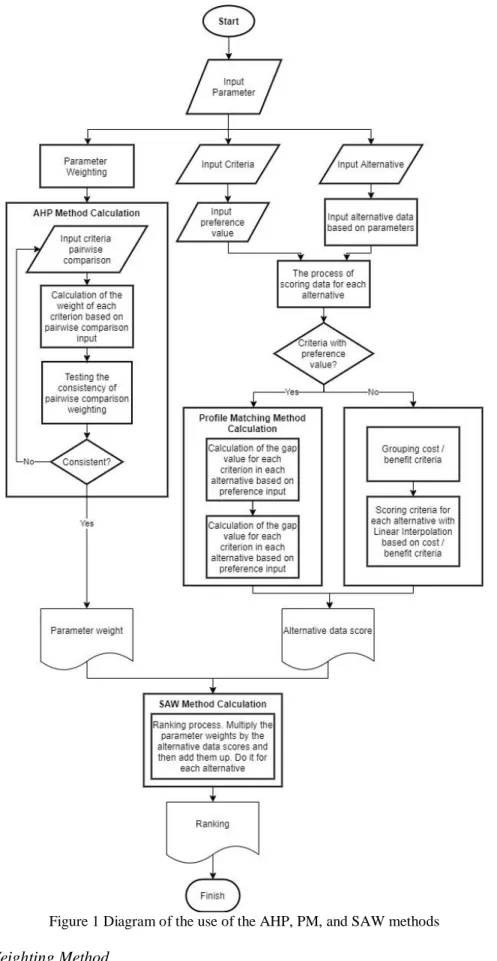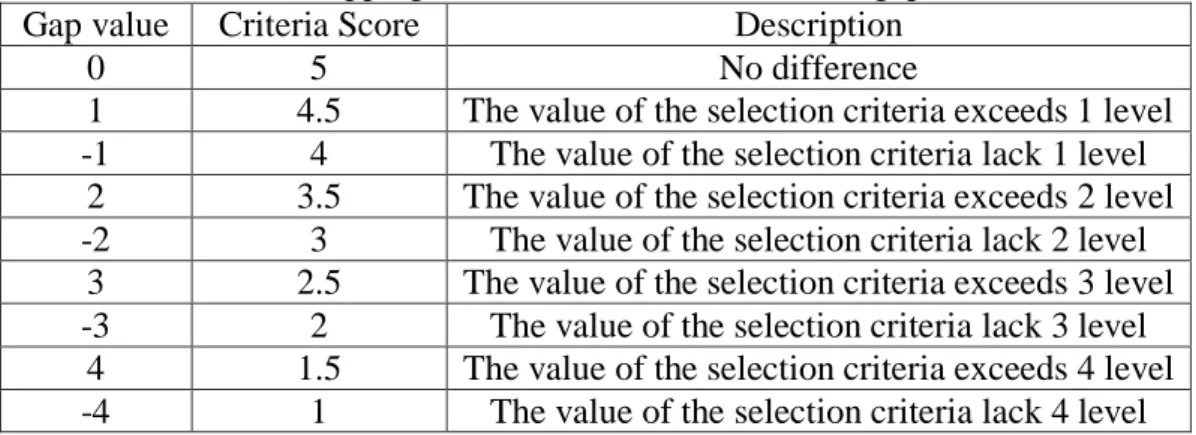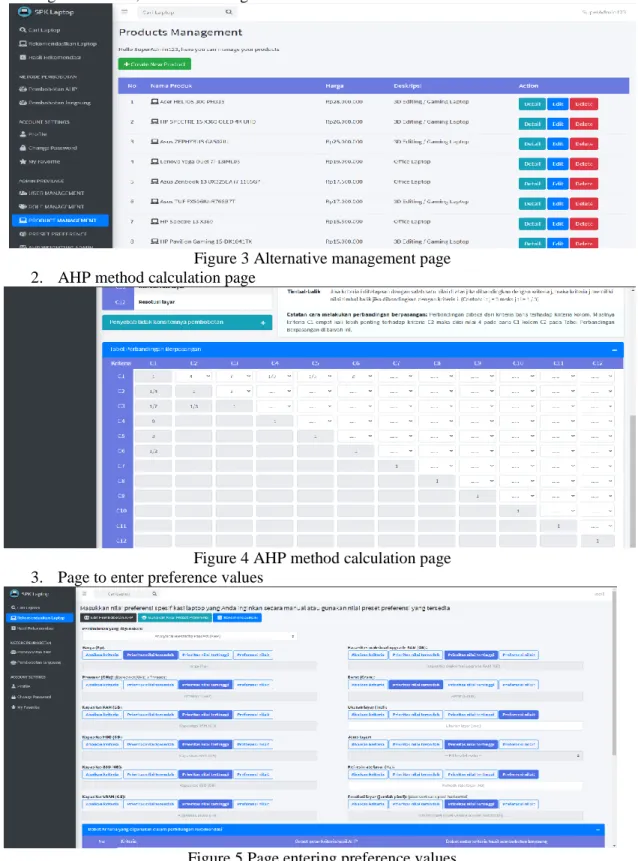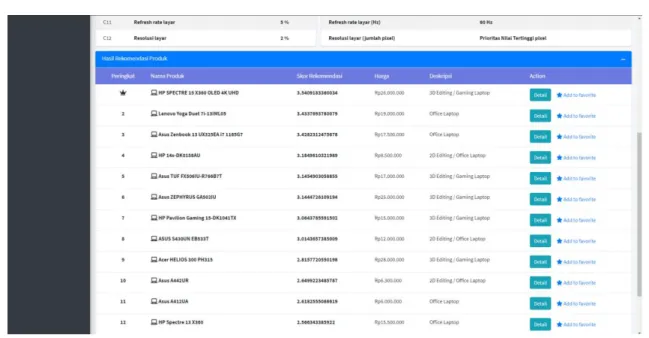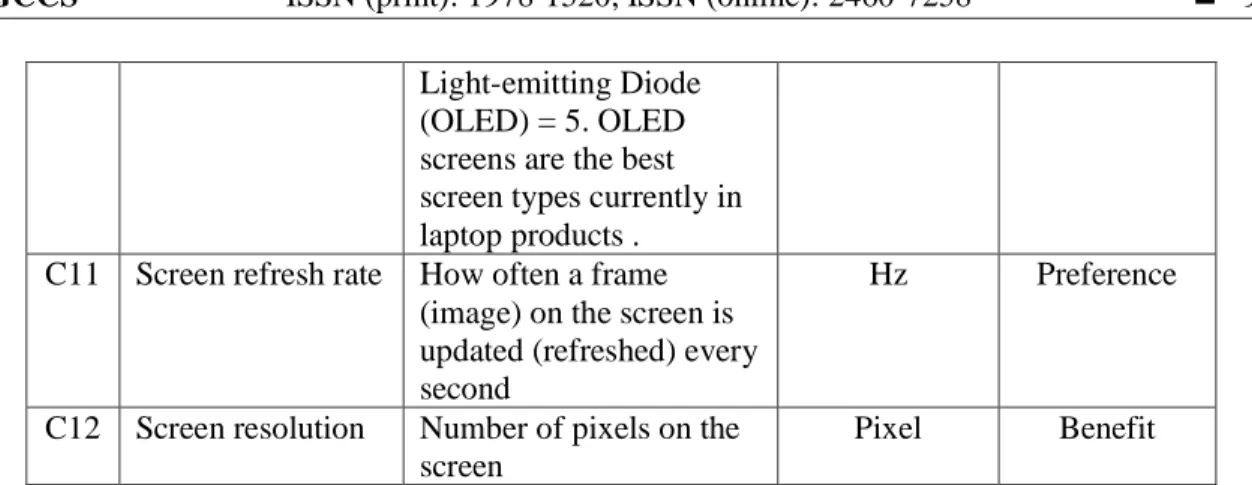ISSN (print): 1978-1520, ISSN (online): 2460-7258
DOI: 10.22146/ijccs.xxxx 1
Decision Support System for Laptop Selection Using AHP Method and Profile Matching
Muhammad Mukharir*1, Retantyo Wardoyo2
1Program studi S1 Ilmu Komputer FMIPA UGM, Yogyakarta
2Departemen Ilmu Komputer dan Elektronika, FMIPA UGM, Yogyakarta, Indonesia e-mail: *1[email protected], 2[email protected]
Abstrak
Laptop adalah personal computer (PC) desktop yang dimensinya diperkecil untuk meningkatkan fleksibilitas dalam penggunaannya. Akan tetapi, banyaknya produk akan membuat kesulitan oleh konsumen dalam menentukan pilihan laptop yang sesuai dengan kebutuhan konsumen yang ingin membelinya.
Tujuan penelitian ini adalah untuk membantu pembeli yang ingin membeli produk laptop sesuai kebutuhan pembeli dengan membuat Sistem Pendukung Keputusan (SPK).
Kriteria yang dipertimbangkan pada penelitian ini ada 12 kriteria yaitu harga, prosesor, kapasitas RAM, kapasitas harddisk, kapasitas SSD, kapasitas V-RAM, kapasitas maksimal upgrade RAM, berat laptop, ukuran layar, jenis layar, refresh rate layar, dan resolusi layar.
Dalam memilih produk laptop ada nilai kriteria dari produk laptop dan nilai kriteria preferensi dari pembeli sebagai pembuat keputusan. Juga nilai-nilai kriteria pada produk laptop memiliki kontribusi berbeda terhadap nilai keseluruhan produk laptop tersebut. Dengan demikian, metode yang dipakai adalah Analytical Hierarchy Process (AHP), Profile Matching (PM) dengan interpolasi linear, dan Simple Addictive Weighting (SAW) untuk menentukan rekomendasi pilihan. Pada akhir penelitian ini diharapkan SPK yang telah dibuat mampu memberikan rekomendasi alternatif pilihan terbaik dan paling sesuai dengan kebutuhan pembeli dalam proses pemilihan produk laptop.
Kata kunci—SPK, Laptop, AHP, Profile Matching, Interpolasi Linear
Abstract
Laptop is a desktop personal computer (PC) whose dimensions are reduced to increase flexibility in its use. However, the large number of products will make it difficult for consumers to choose a laptop that suits the needs of consumers who want to buy it.
The purpose of this research is to help buyers who want to buy laptop products according to their needs by making a Decision Support System (DSS). There are 12 criteria considered in this research, price, processor, RAM capacity, hard disk capacity, SSD capacity, V-RAM capacity, maximum RAM upgrade capacity, laptop weight, screen size, screen type, screen refresh rate, and screen resolution. Choosing a laptop product there is a criterion value of a laptop product and a value of preference criteria from the buyer as a decision maker. Also the criteria values on laptop products have different contributions to the overall value of the laptop product. Thus, the methods used are Analytical Hierarchy Process (AHP), Profile Matching (PM) with linear interpolation, and Simple Addictive Weighting (SAW) to determine the recommended options. Lastly, SPK that has been made will be able to provide recommendations best alternative choices and best suit the needs of buyers for selecting laptop products.
Keywords— SPK, Laptop, AHP, Profile Matching, Linear Interpolation
ISSN (print): 1978-1520, ISSN (online): 2460-7258 2
1. INTRODUCTION
A laptop is a desktop personal computer (PC) whose dimensions are reduced to increase flexibility in its use. The hardware contained in it is exactly the same as the components on the desktop, only made lighter, less hot, reduced in size, and more energy efficient. The material, size, and hardware installed in the laptop affect the weight of the laptop.
Currently, there are many laptop products on the market. Various brands offer a variety of laptop products, as well as services in the form of repairs, and different warranty periods.
Laptop manufacturers in each brand of course consider the target consumers who want to be reached by the product to be made. This causes many variations of laptop specifications and prices on the market. The number of laptop products will make it difficult for consumers to choose a laptop that suits their needs. Therefore, a decision support system (DSS) is needed to assist consumers in choosing laptop products.
Some of what has been done is research by Cahyaning M. W. [1], Perdhana et al. [2], Hartanto and Prasetyowati [3], and Saragih [4] each of the studies that have been carried out by these researchers makes the DSS for selecting laptops using (AHP). The main differentiator of the research lies in the use of criteria in assessing laptop alternatives. However, from the research that has been done, no one has researched using the AHP and PM methods in making SPK for laptop selection.
The Analytical Hierarchy Process (AHP) is a multi-criteria decision-making technique in which decision makers set priorities and determine decisions by making pairwise comparisons between criteria to obtain priorities in each hierarchy [5]. The use of the AHP method has an important role in the case of laptop selection because each criterion on the laptop has a different value contribution to the overall value of the laptop product. Therefore, the AHP method is used.
The Profile Matching (PM) method is used to assess criteria that are close to the ideal value desired by decision makers. In the PM process, the process of comparing the laptop specifications with the target specifications or ideal values desired by the decision maker is carried out. So there is a difference in the value of the laptop product specification with the target specification value (also known as the gap), the smaller the gap, the higher the score, meaning the greater the opportunity for an alternative choice to be recommended [6]. Every individual certainly has various goals and needs in buying laptop products. That means everyone has their own preferences in choosing a laptop product. In this regard, the PM method is used. Thus, this research aims to design and make SPK for laptop selection using the AHP and PM methods.
2. METHODS 2.1 Research Description
The purpose of this
researchis to implement the AHP, PM, and SAW methods to build a web-based decision support system to help buyers who will buy laptops in choosing laptop products that suit their needs. The AHP method is used to calculate the weights between criteria. The PM method is used to calculate the value of the scoring process on the criteria that use the user's preference value.
The first step is, the user enters the value of the pairwise comparison criteria in
the system. Then enter the target value / preference criteria for the desired laptop. Next,
the system will process the user input value, and then display the appropriate laptop
recommendation results. The flow of used method is shown in Figure 1.
Figure 1 Diagram of the use of the AHP, PM, and SAW methods
2.2 AHP Weighting Method
AHP is a multi-criteria decision-making method. AHP is used to obtain a ratio scale from discrete and continuous pairwise comparisons. This comparison can be taken from a
ISSN (print): 1978-1520, ISSN (online): 2460-7258 4
fundamental scale that reflects the relative strength of preferences and feelings or actual measurements [5].
The first step of the AHP method is to perform pairwise comparisons by creating a pairwise comparison matrix based on the Saaty fundamental scale using equation (1).
(1)
The next step is to normalize the matrix with pairwise comparisons with the equation (2).(2)
Then calculate the weight of each criterion by adding horizontally and then dividing by many criteria using equation (3).(3)
After the weights between criteria are obtained, the next step is to check the consistency of the weights by calculating the Consistency Ratio (CR) value. To get the CR value, the first step is to calculate the WSV value with equation (5). Equation (4) is used to obtain a pairwise comparison matrix that has been multiplied by the weight of the criteria obtained. The pairwise comparison matrix subjected to the function is the matrix before normalization.(4) (5)
After the WSV value is obtained, then calculate the Consistency Vector (CV) value by dividing the WSV by the weight of the criteria corresponding to the row using equation (6).
(6)
Then calculate the maximum eigenvalue (λmax) by adding up the CV values and then dividing by many criteria using equation (7).(7)
The next step is to calculate the Consistency Index (CI) value with equation (8).
(8)
Then the Consistency Ratio (CR) value is calculated using equation (9).
(9)
If the CR value is less than 0.1 then the comparison is considered consistent and the weights can be used for calculations in making decisions. If not, it is necessary to re-comparison until the CR value is less than 0.1.
2.3 Profile Matching Method
Profile Matching (PM) is a multi-criteria decision-making method by determining the value of the ideal or feasibility criteria that must be met by alternative choices. This method
aims to find the ideal option. This means that the alternative choice sought by the decision maker is an option that has a criterion value that is close to the criterion value determined by the decision maker, not the maximum or minimum value. Thus, the alternative choice that has the closest criterion value to the criterion value determined by the decision maker is more recommended [7].
In this research the range of scores used is from one to five. Following are the steps of the PM method.
1. Calculating the value of the alternative criteria gap against the criterion preference value using equation (10).
(10)
2. After obtaining the Gap value, the next step is to provide a score for each criterion gap value. Gap score mapping with exact score criteria is determined based on Table 1 below.
Table 1 Mapping of criteria scores based on the gap value
Gap value Criteria Score Description
0 5 No difference
1 4.5 The value of the selection criteria exceeds 1 level -1 4 The value of the selection criteria lack 1 level
2 3.5 The value of the selection criteria exceeds 2 level -2 3 The value of the selection criteria lack 2 level
3 2.5 The value of the selection criteria exceeds 3 level -3 2 The value of the selection criteria lack 3 level
4 1.5 The value of the selection criteria exceeds 4 level -4 1 The value of the selection criteria lack 4 level
If the gap value is a real number, then a triangular piece wise linear interpolation is used to calculate the criterion score based on the gap. Linear interpolation will be explained in section 2.4.
2.4 Linear Interpolation
For criteria that use preference values with real number gap values, a criterion score is given based on the gap value with equation (11) [8].
(11)
With the following caption.
score(x): Interpolated criteria scores.
: The upper limit of the interpolated result range (maximum score).
: The lower limit of the interpolated range (minimum score).
: The value of the gap farthest from zero.
: The value of the criteria before interpolation.
For the cost category criteria and the profit category criteria, scores are calculated using interpolation with equation (12).
(12)
ISSN (print): 1978-1520, ISSN (online): 2460-7258 6
With the following caption.
score(data) : Interpolated criteria scores.
: The upper limit of the interpolated result range (maximum score).
: The lower limit of the interpolated range (minimum score).
: Minimum alternative data value on the criteria.
: The maximum alternative data value on the criteria.
: The value of the criteria before interpolation.
2.5 System Architecture
The system architecture describes how the system works. Before gaining access to the system, the user is required to Login. If the user does not have an account, the user can register as a new user. The system has two types of access, namely access as admin and access as user.
Admin has the authority to enter, read, change, delete, alternative data options, enter pairwise comparison values between criteria, enter criteria or target values as decision makers, and view the results of system recommendations. Ordinary users have the authority to enter the value of pairwise comparisons between criteria, enter the ideal value or target value of the desired specification as a decision maker, and view the results of selected recommendations. Details of the system architecture are shown in Figure 2.
Figure 2 Use case diagram of laptop selection DSS 2.6 System Implementation
The following is the implementation of a laptop selection decision support system.
1. Alternative Management Page
This page is intended for management so that admins can manage product alternative information, including adding new alternatives, updating alternative information, and deleting existing alternatives, as shown in Figure 3.
Figure 3 Alternative management page 2. AHP method calculation page
Figure 4 AHP method calculation page 3. Page to enter preference values
Figure 5 Page entering preference values 4. Recommended results page
ISSN (print): 1978-1520, ISSN (online): 2460-7258 8
Figure 6 Recommended results page 3. RESULT AND DISCUSSION 3.1 Data
The data needed is detailed information on laptop product specifications. The information includes price, processor, RAM capacity, hard disk capacity, SSD capacity, V- RAM capacity, maximum RAM upgrade capacity, laptop weight, screen size, screen type, screen refresh rate, and screen resolution. Product information is obtained from the web that can be accessed by the public. The criteria used to evaluate laptop products are shown in Table 2.
Table 2 Assessment criteria for the laptop used
No Criteria Description Unit of Value Category
C1 Price Laptop price Rp Cost
C2 Processor Processor speed is calculated by multiplying the base clock by the number of threads
GHz Benefit
C3 RAM Capacity Laptop RAM Capacity GB Benefit
C4 Hard disk Capacity
Laptop hard disk capacity GB Benefit
C5 SSD Capacity Product SSD capacity GB Benefit
C6 V-RAM Capacity V-RAM capacity, is the RAM capacity of the GPU
GB Benefit
C7 Maximum capacity of RAM upgrade
Maximum capacity for upgrading RAM on laptops
GB Benefit
C8 Laptop weight Laptop product weight Gram Cost
C9 Screen size Laptop screen size Inci Preference
C10 Screen type The types and ratings of laptop screens used are:
Twisted Nematic (TN) = 1, In-Plane Switching (IPS) = 3, and Organic
Direct unit of assessment
Benefit
Light-emitting Diode (OLED) = 5. OLED screens are the best screen types currently in laptop products . C11 Screen refresh rate How often a frame
(image) on the screen is updated (refreshed) every second
Hz Preference
C12 Screen resolution Number of pixels on the screen
Pixel Benefit
The data that has been obtained and used in this research are shown in Table 3.
Table 3 Results of alternative data collection
Alternative C1 C2 C3 C4 C5 C6 C7 C8 C9 C10 C11 C12 A1 28000000 36.8 8 0 512 8 32 2500 15 3 240 2073600 A2 26000000 31.2 16 0 1000 4 16 2090 15 5 60 8294400 A3 25000000 48 8 0 1000 6 24 2100 15 3 144 2073600 A4 19000000 18.4 16 0 512 1 16 1100 13 3 60 2916000 A5 17500000 10.4 16 0 512 1 16 1100 13 3 60 2073600 A6 17000000 46.4 8 1000 256 6 32 2300 15 5 144 2073600 A7 15500000 8.8 8 0 256 1 8 1200 13 3 60 8294400 A8 15000000 31.2 8 1000 256 4 32 2250 15 3 144 2073600 A9 12000000 12.8 8 1000 256 2 20 1400 14 3 60 2073600 A10 8500000 16.8 8 0 512 2 20 1470 14 3 60 2073600 A11 6300000 12.8 4 1000 0 2 20 1400 14 1 60 1049088 A12 6000000 9.2 4 0 512 1 12 1500 14 1 60 2073600 A13 5400000 10.4 4 0 256 1 12 1600 14 1 60 1049088 A14 4700000 7.2 4 1000 0 1 8 1650 14 1 60 1049088 A15 3900000 3.6 4 500 0 1 12 1460 11 1 60 921600
3.2 Processing Results with AHP weighting, Profile Matching, and Linear Interpolation
After getting the input value in the form of pairwise comparisons, the system will perform the weight calculation process using the AHP method. To input criteria values with user preferences, the criteria score values are calculated using the PM method. For criteria without preferences, a process of grouping the criteria will be carried out as a cost category criterion or as a profit criterion and then a score will be given using linear interpolation according to the type of criteria category. The results of the recommendations can be seen in Figure 6 in section 2.6.
3.3 System Test Results
Functional system testing is carried out with User Acceptance Test (UAT) to ensure the system functions as expected. Non-functional system testing is also carried out in order to get feedback from users, whether the system helps or not. Non-functional testing involved 10 respondents. Respondents were asked to try the system, then respondents filled out an assessment questionnaire related to the evaluation of the decision support system that had been built.
ISSN (print): 1978-1520, ISSN (online): 2460-7258 10
From the test results, the value categories for aspects of reliability, ease of use, data integrity, and usability are very good, which means the system can work properly, and also helps users in providing recommendations for laptop products according to user preferences.
4. CONCLUSION
To calculate the final score recommendation of a laptop product used for the SAW method. The input values for the SAW method are the value of the weighted criteria for the weighted calculation of the AHP method, the value of the calculation results of the PM method, and the value for calculating the cost and benefit criteria using linear interpolation. The output of the SAW method is the recommendation score of a laptop product. The process carried out for each product alternative. The recommendation score is used for ranking where the higher the recommendation score on a product is recommended by the product.
Results based on testing, the decision support system provides accurate information and results, so that the system is reliable. The test results show that the user interface of the decision support system is attractive, the instructions help the user in operating the system, and the system is easy to use. Results based on the test, the decision support system helps the user in determining the laptop product that suits the user's needs.
This system can still be improved to assist decision makers in solving decision-making problems. To conduct further research, there are several suggestions that can be given based on this research. First, the addition of assessment criteria in assessing alternative options allows it to provide recommendations for alternative choices that are in accordance with decision makers.
Second, other decision-making techniques can be applied, especially when developing DSS to solve certain problems that require certain methods. Third, providing more alternatives will give decision makers more choices so that decision makers can find results that better suit their needs.
REFERENCES
[1] Cahyaning M.W., P., 2014, Penerapan Metode Analytical Hierarchy Process (AHP) Untuk Membantu Pembeli dalam Pemilihan Laptop pada Pazia Computer Semarang, Skripsi, Fakultas Ilmu Komputer, Universitas Dian Nuswantoro, Semarang.
[2] Perdhana, A.S., Laksito YS, W., dan Siswanti, S, 2014. Sistem Pendukung keputusan Pemilihan Jenis Laptop dengan Menggunakan Metode Analytical Hierarchy Process, J.
Tekno. Infor. Kom. Sin. Nus, 1, 1.
[3] Hartanto, T. dan Prasetiyowati, M.I., 2012, Sistem Pendukung Keputusan Pemilihan Laptop Berbasis Web dengan Metode Analytical Hierarchy Process (Studi Kasus:
SAMCO Computer), J. Univ. Mult. Nus., 2085-4552.
[4] Saragih, S.H., 2013, Penerapan Metode Analitycal Hierarchy Process (AHP) pada Sistem Pendukung Keputusan Pemilihan Laptop.
[5] S Saaty, R.W., 1987, The Analytic Hierarchy Process-What It Is and How It Is Used, Mathematical Modelling, Volume 9, pp. 161-176.
[6] Turban, E., Aronson, J.E., dan Liang, T., 2007, Decision Support Systems and Intelligent Systems, edisi 7, Prentice-Hall, New Jersey.
[7] Jumadi., Alam, C.N., dan Taufik., I., 2015, Pendekatan Logika Fuzzy untuk Perhitungan Gap pada Metode Profile Matching dalam Menentukan Kelayakan Proposal Penelitian, Prosiding Seminar Nasional Sains dan Teknologi 2015, 22-23 April 2015, Bandung, Indonesia.
[8] Andriyani, W., Hartati, S., Wardoyo, R., dan Wibowo, S., 2019. A Development of Modified Profile Matching and Borda for Determining Treatment Priorities for Hemorrhage Stroke Patients, Int. J. Sci. & Eng. Res., vol 10, 2229-5518.
